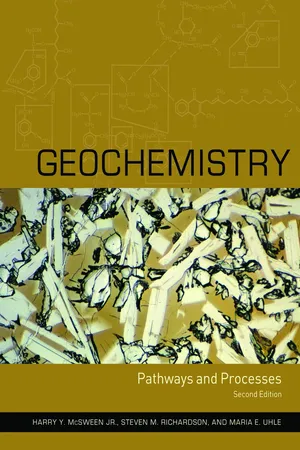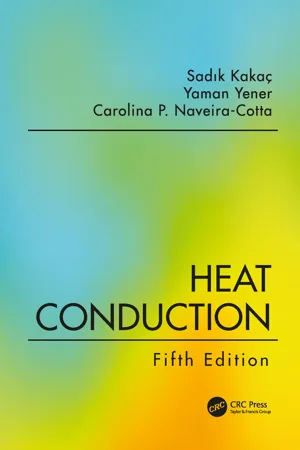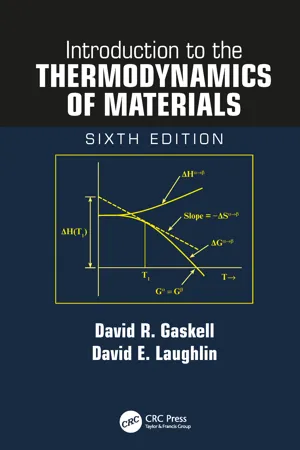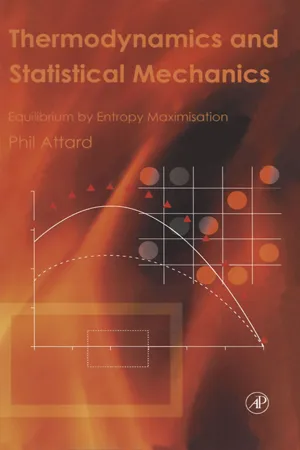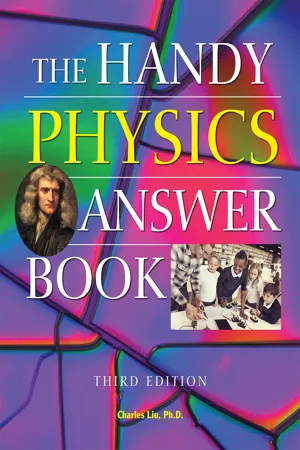Physics
Thermal Equilibrium
Thermal equilibrium refers to a state in which two or more objects or systems are at the same temperature and there is no net flow of heat between them. In this state, the thermal energy is evenly distributed, and there is no change in temperature over time. It is a key concept in understanding heat transfer and the behavior of systems in thermal contact.
Written by Perlego with AI-assistance
Related key terms
Related key terms
1 of 4
Related key terms
1 of 3
5 Key excerpts on "Thermal Equilibrium"
- eBook - ePub
Geochemistry
Pathways and Processes
- Harry McSween, Steven Richardson, Maria Uhle(Authors)
- 2003(Publication Date)
- Columbia University Press(Publisher)
Gibbs-Duhem equation. It tells us that there can be no net gradients in intensive parameters at equilibrium. Of more specific interest in geochemical problems, at constant temperature and pressure, there can be no net gradient in internal energy as a result of composition in a phase in internal equilibrium. This can be seen, in a way, as another way of stating the conclusions from our discussion of heterogeneous equilibrium.SUMMARYWhat is equilibrium? Our discussion of the three laws of thermodynamics has led us to discover several characteristics that answer this question. First, systems in equilibrium must be at the same temperature: this is the condition of Thermal Equilibrium. Second, provided that work is exclusively defined as the integral of PdV, there can be no pressure gradient between systems in equilibrium: this is the condition of mechanical equilibrium. Finally, the chemical potential of each component must be the same in all phases at equilibrium. This is the least obvious of the conditions we have discussed, and is the focus of many discussions in subsequent chapters.We have also repackaged the internal energy function in several ways and examined the role of entropy, which will always be maximized during the approach to equilibrium. To demonstrate that each of the equilibrium criteria is a direct consequence of the three laws, we used the internal energy function, E(S, V, n), as the basis of our discussion. As we progress, though, we will quickly abandon E in favor of the Gibbs free energy. Any of the energy functions, however, can be used to clarify the conditions of equilibrium.SUGGESTED READINGSWith the ideas we have introduced in this chapter, we are now ready to begin exploring geologic environments. This has only been a first look at thermodynamics, however. We return to the topic many times.There are many good introductory texts in thermodynamics, although most are written for chemists rather than for geochemists. Among the best, or at least most widely used, texts for geochemists are listed here, along with excellent but challenging articles and historical accounts.Denbigh, K. 1968. The Principles of Chemical Equilibrium. London: Cambridge University Press. (Heavy going, but almost anything you want to know is in here somewhere.)Ferry, J. M., ed. 1982. Characterization of Metamorphism through Mineral Equilibria - eBook - ePub
- Sadık Kakac, Yaman Yener, Carolina P. Naveira-Cotta(Authors)
- 2018(Publication Date)
- CRC Press(Publisher)
The dimensions of a system or a control volume may be finite or they may even be infinitesimal. The complete definition of a system or a control volume must include at least the implicit definition of a coordinate system, since the system or the control volume can be stationary or may even be moving with respect to the coordinate system.The characteristic of a system we are most interested in is its thermodynamic state , which is described by a list of the values of all its properties . A property of a system is either a directly or an indirectly observable characteristic of that system which can, in principle, be quantitatively evaluated. Volume, mass, pressure, temperature, etc. are all properties. If all the properties of a system remain unchanged, then the system is said to be in an equilibrium state . A process is a change of state and is described in part by the series of states passed through by the system. A cycle is a process wherein the initial and final states of a system are the same.If no energy transfer as heat takes place between any two systems when they are placed in contact with each other, they are said to be in Thermal Equilibrium . Any two systems are said to have the same temperature if they are in Thermal Equilibrium with each other. Two systems not in Thermal Equilibrium would have different temperatures, and energy transfer as heat would take place from one system to the other. Temperature is, therefore, the property of a system that measures its “thermal level.”The laws of thermodynamics deal with interactions between a system and its surroundings as they pass through equilibrium states. These interactions may be divided into two as (1) work or (2) heat - eBook - ePub
- David R. Gaskell, David E. Laughlin(Authors)
- 2017(Publication Date)
- CRC Press(Publisher)
Chapter 2 .The system may be a machine (heat engine) or a device (transducer) of interest to us. In the study of the thermodynamics of materials, the system is usually composed of matter, which is anything that has mass and occupies space. Matter has a given temperature, pressure, and chemical composition, as well as physical properties such as thermal expansion, compressibility, heat capacity, viscosity, and so on. A central aim of applied thermodynamics is the determination of the effect of the surroundings on the equilibrium state of a given system. Since the surroundings interacts with the system by transferring or receiving various forms of energy or matter with it, another focus of applied thermodynamics is the establishment of the relationships which exist between the equilibrium state of a given system and the influences which have been brought to bear on it.1.2THE CONCEPT OF STATEA fundamental concept in thermodynamics is that of the thermodynamic state . If it were possible to know the masses, velocities, positions, and all modes of motion (translational, rotational, etc.) of all of the constituent particles in a system, this knowledge would serve to describe the microscopic state of the system, which, in turn, would determine, in principle, all of the thermodynamic variables of the system that can be measured (energy, temperature, pressure, etc.). For systems with macroscopic dimensions, this would entail more than 1024 coordinates, which is clearly an impossible task. In the absence of such detailed knowledge as is required to determine the microscopic state of the system, classical thermodynamics begins with a consideration of the variables of the system, which, when determined, completely define the macroscopic state of the system; that is, when all of the thermodynamic variables are fixed, then the macroscopic state of the system is fixed and is said to be in equilibrium. It is found that when the values of a small number of thermodynamic variables are fixed, the values of the rest of the thermodynamic variables are also fixed. Indeed, when a simple system such as a given quantity of a substance of fixed composition is being considered, the fixing of the values of two of the thermodynamic variables fixes the values of the rest of the thermodynamic variables. Thus, only two thermodynamic variables are independent, which, consequently, are called the independent thermodynamic variables of the system. All of the other variables are dependent variables . The thermodynamic state of such a system is thus uniquely determined when the values of the two independent variables are fixed. This has been called the Duhem*postulate - eBook - ePub
Thermodynamics and Statistical Mechanics
Equilibrium by Entropy Maximisation
- Phil Attard(Author)
- 2002(Publication Date)
- Academic Press(Publisher)
The second law of thermodynamics implies that equilibrium corresponds to the maximum total entropy, and that a system prepared in a nonequilibrium macrostate will move in the direction of increasing entropy. The statistical interpretation, as exemplified in the first chapter, is that the equilibrium macrostate is the most probable macrostate (i.e., the one with the largest weight), and hence it is the state of maximum entropy. A system moves toward equilibrium because there is a greater weight of states in that direction than in the opposite direction. Here these facts are used to derive what is essentially the zeroth law of thermodynamics, namely that two systems in Thermal Equilibrium have the same temperature.In what follows it will be important to distinguish between dependent and independent variables. When the energy is independently specified it will be denoted simply E , and when it is a dependent variable it will be denoted E (N, V, T ), or Ē (N, V, T ), or simply Ē. The first quantity is a well-defined property of an isolated system and E (N, V, T ) is given implicitly by(2.5)It will be shown below that the thermodynamic state is unique, and hence there is a one-to-one relationship between the thermodynamic variables. In particular this means that one may write E 1 = E (N, V, T 1 ) ⇔ T 1 = T (E 1 , N,V ). An overline is used to denote the equilibrium state; Ē (N, V, T ) is the equilibrium energy of a subsystem with N particles in a volume V in contact with a thermal reservoir of temperature T.Consider an isolated system comprising a subsystem 1 in thermal contact with a heat reservoir 2 (Fig. 2.1 ). A reservoir in general is defined by two characteristics: it is infinitely larger than the subsystem of interest, and the region of mutual contact is infinitely smaller than the subsystem. The first property means in this case that the amount of energy exchangeable with the subsystem is negligible compared to the total energy of the reservoir. The second property ensures that interactions between the subsystem and the reservoir, while necessary to establish Thermal Equilibrium, are relatively negligible. That is, the total entropy of the system is equal to the sum of the entropies of the subsystem and the reservoir. S total = S 1 + S 2 - eBook - ePub
- Charles Liu(Author)
- 2020(Publication Date)
- Visible Ink Press(Publisher)
THERMODYNAMICS
What is thermodynamics?
Thermodynamics is the study of the change of thermal energy in objects and materials that makes them warm and cold, how they interact with each other, and the relationship between energy, heat, and work. It can be a challenging area of physics, in part because most of the vocabulary dates from the time before scientists understood what makes an object hot. Terms like “heat,” “heat capacity,” and “latent heat” suggest that warm objects contain some material that reacts to temperature. It wasn’t until the early 1800s that our present understanding started to develop. Some 200 years later, our common usage of these terms is still based on earlier ideas.What is thermal energy?
Thermal energy is the random kinetic energy of the moving particles—such as atoms and molecules—that make up matter. Objects expand when heated, so the bonds holding the particles together stretch. That means they have more elastic energy. So, thermal energy is the sum of the kinetic and elastic energy of the atoms and molecules and the bonds that hold them together. It is energy that is inside the object, so it is called a form of internal energy.THERMAL PHYSICS
Who discovered what makes an object hot?
Benjamin Thompson, Count Rumford (1753–1814), who was born in the Massachusetts Bay Colony but did most of his scientific work in the Kingdom of Bavaria (which is now part of Germany), deserves a great deal of credit in discovering what makes things hot. Before his experiments, most scientists thought that hot objects contained an invisible fluid called caloric. Experiments done before Rumford showed that when you heated an object it didn’t gain weight, so caloric must be weightless as well as invisible. This result made many scientists suspicious of the caloric explanation.In 1789 Rumford drilled holes in bronze cannons through which a cannonball would be shot. He found that both the cannon and the metal chips that resulted from the drilling became hot. He determined the amount of water that could be raised to the boiling point by both the cannon bodies and the chips and showed that the caloric theory did not agree with his results. He finally concluded that in hot objects, the particles that made up the material moved faster than they moved in cold objects. Using our present terminology, they had more kinetic energy. In their motion they vibrate back and forth; they do not move together from one place to another like a thrown ball.
Index pages curate the most relevant extracts from our library of academic textbooks. They’ve been created using an in-house natural language model (NLM), each adding context and meaning to key research topics.
Explore more topic indexes
Explore more topic indexes
1 of 6
Explore more topic indexes
1 of 4
